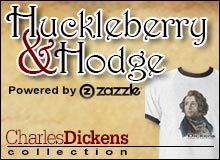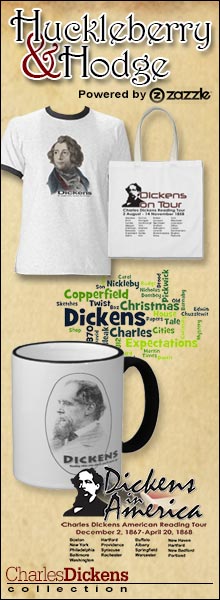Charles Dickens' Journalism
Explore Charles Dickens' work as a reporter and his later weekly magazines
Dickens' weekly magazines:Charles Dickens' Early Journalism
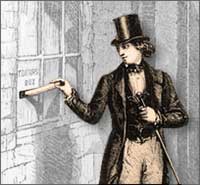
Charles Dickens submitting his first manuscript
It is not surprising that Charles Dickens’ extraordinary powers of observation were sharpened early on as a journalist. In early 1832 Dickens, after a brief career as a solicitor's clerk and teaching himself shorthand, became a parliamentary reporter for the Mirror of Parliament, a newspaper owned by his mother's brother, John Henry Barrow. He was also doing parliamentary reporting for the True Sun, a new radical newspaper (Slater, 2009, p. 27-37).
During his parliamentary reporting days he submitted his first sketch, A Dinner at Poplar Walk, which was published in Monthly Magazine in December, 1833. Forster reports that Dickens submitted the manuscript "stealthily one evening at twilight, with much fear and trembling, into a dark letter-box in a dark office up a dark court in Fleet Street" (Forster, 1899, v. 1, p. 59).
In 1834 Dickens became a reporter for the Morning Chronicle, a leading daily newspaper, doing parliamentary reporting (Slater, 2009, p. 42). Dickens would later fondly recall the exciting times reporting for the Morning Chronicle, dashing about the country scribbling inky reports with his pad balanced on his knee in a bouncing coach racing back to London trying to beat the Times to the story (Ackroyd, 1990, p. 155-156).
Dickens contined to publish popular sketches in Monthly Magazine although receiving no remuneration. Dickens began to be paid for his sketches in the Morning Chronicle, as well as other periodicals during this time, including the Evening Chronicle which was edited by his future father-in-law George Hogarth. Charles Dickens, the journalist, was becoming Boz, the author (Slater, 2009, p. 40-47). Dickens was approached by publisher John Macrone to collect his sketches and publish them in volume form. The result was Sketches by Boz in 1835 (Ackroyd, 1990, p. 174).
Dickens resigned from the Morning Chronicle in 1836 to become the first editor of a new weekly, Bentley's Miscellany, owned by Richard Bentley (Ackroyd, 1990, p. 201-202). Dickens was writing Pickwick Papers for another publisher, Chapman and Hall, at the same time. Dickens contributed several original stories for Bentley's in addition to publishing Oliver Twist in 24 weekly installments in the magazine (Forster, 1899, v. 1, p. 77-78).
Dickens left Bentley's in February, 1839 (Davis, 1999, p. 25). Soon he would begin a new journalistic endeavor, this time on his own terms (Ackroyd, 1990, p. 289).
Charles Dickens' Weekly MagazinesMaster Humphrey's Clock
April 4, 1840 - Dec 4, 1841Buy it at Amazon.com
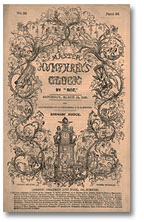 A weekly journal written entirely by Dickens. The premise of the journal was that the kindly old gentleman, Master Humphrey, along with his friends, gathered weekly by the fire to read stories stored in Master Humphrey's old grandfather clock. Some original stories brought back popular characters from Pickwick Papers (Johnson, 1952, p. 295-296). Illustrations for the magazine were produced on wood blocks which meant that the lines for the images were raised like the text. This way the images could be dropped into the story near the same text that was being illustrated (Steig, 1978, p. 51).
A weekly journal written entirely by Dickens. The premise of the journal was that the kindly old gentleman, Master Humphrey, along with his friends, gathered weekly by the fire to read stories stored in Master Humphrey's old grandfather clock. Some original stories brought back popular characters from Pickwick Papers (Johnson, 1952, p. 295-296). Illustrations for the magazine were produced on wood blocks which meant that the lines for the images were raised like the text. This way the images could be dropped into the story near the same text that was being illustrated (Steig, 1978, p. 51).
After initial success, sales slumped and Dickens introduced The Old Curiosity Shop. The story of Little Nell and her grandfather initially was to be just another of Master Humphrey’s short personal adventures; however, the tale captured the imagination of its author, as well as the public, and the serialization of The Old Curiosity Shop, after appearing intermittently at first, soon took over the entire publication (Johnson, 1952, p. 297-298). This explains the appearance of Master Humphrey as the initial storyteller who mysteriously disappears, then reappears rather clumsily, at the novel's conclusion. Weekly sales skyrocketed to an unprecedented 100,000 copies with the story progressing week to week (Patten, 1978, p. 110).
At the conclusion of The Old Curiosity Shop Master Humphrey segues immediately into Barnaby Rudge, which filled the Clock until November, 1841 . This was quickly followed by the death of Master Humphrey (Slater, 2009, p. 161-173).
Dickens closes the clock with " My task is done. The chamber in which we have whiled away so many hours, not, I hope, without some pleasure and some profit, is deserted; our happy hour of meeting strikes no more; the chimney-corner has grown cold; and Master Humphrey’s Clock has stopped forever" (Master Humphrey's Clock, p. 118).
Household Words
Mar 27, 1850 - May 28, 1859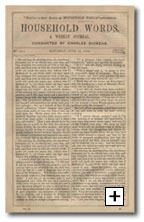 Weekly magazine which Dickens edited along with sub-editor W. H. Wills. Dickens received a salary and additional payments for his own contributions. The weekly contained topical journalism, essays, short fiction, and poetry by a total of 380 contributors. It was published every Wednesday at a cost of twopence and consisted of 24 pages of double columns without illustration. The magazine proved a financial success and turned what Dickens decribed as "a good round profit." Although serial publication was not planned for the journal, Dickens published his novel Hard Times in Household Words in order to bolster sales during a period of reduced profit. Dickens' total contribution to the weekly included 108 full-length essays and articles, co-writing another 45. Dickens oversaw every aspect of the magazine, besides submitting his own pieces he often altered articles written by other contributors that proved unsuitable to him. After quarreling with his publisher, Bradbury and Evans, Dickens discontinued Household Words and the journal was incorporated into a new weekly, All the Year Round (Schlicke, 1999, p. 281-286). 31 of the articles Dickens wrote for Household Words were published as Reprinted Pieces in 1858 (Davis, 1999, p. 338).
Weekly magazine which Dickens edited along with sub-editor W. H. Wills. Dickens received a salary and additional payments for his own contributions. The weekly contained topical journalism, essays, short fiction, and poetry by a total of 380 contributors. It was published every Wednesday at a cost of twopence and consisted of 24 pages of double columns without illustration. The magazine proved a financial success and turned what Dickens decribed as "a good round profit." Although serial publication was not planned for the journal, Dickens published his novel Hard Times in Household Words in order to bolster sales during a period of reduced profit. Dickens' total contribution to the weekly included 108 full-length essays and articles, co-writing another 45. Dickens oversaw every aspect of the magazine, besides submitting his own pieces he often altered articles written by other contributors that proved unsuitable to him. After quarreling with his publisher, Bradbury and Evans, Dickens discontinued Household Words and the journal was incorporated into a new weekly, All the Year Round (Schlicke, 1999, p. 281-286). 31 of the articles Dickens wrote for Household Words were published as Reprinted Pieces in 1858 (Davis, 1999, p. 338).
All the Year Round
April 30, 1859 - 1893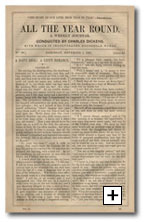 Dickens' successor to Household Words took the same format as its predecessor. Dickens contributed less material to All the Year Round than he had for Household Words, although he did serialize A Tale of Two Cities and Great Expectations in the weekly. Dickens owned 75% of the venture and served as editor until his death in 1870 at which time his son Charley took over as editor for some time. The magazine ceased publication in 1895 (Schlicke, 2011, p. 12). A collection of the sketches Dickens wrote for All the Year Round were later published as The Uncommercial Traveller (Davis, 1999, p. 396).
Dickens' successor to Household Words took the same format as its predecessor. Dickens contributed less material to All the Year Round than he had for Household Words, although he did serialize A Tale of Two Cities and Great Expectations in the weekly. Dickens owned 75% of the venture and served as editor until his death in 1870 at which time his son Charley took over as editor for some time. The magazine ceased publication in 1895 (Schlicke, 2011, p. 12). A collection of the sketches Dickens wrote for All the Year Round were later published as The Uncommercial Traveller (Davis, 1999, p. 396).
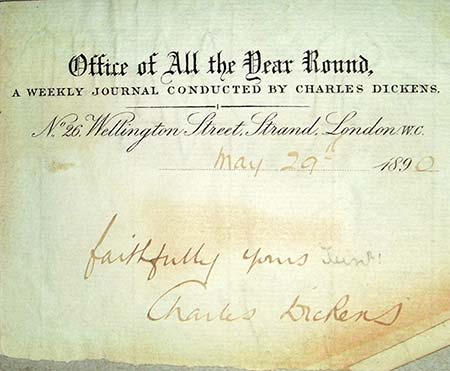
While there seems to be some discussion about how long Charles Dickens Jr. served as editor of All the Year Round, this signed bookplate seems to indicate that he was still editor in May, 1890. Bookplate photo compliments of Norman Walmsley.
Cover of the November 3, 1860 edition of All The Year Round
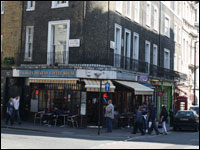 All the Year Round Offices
All the Year Round OfficesThe offices of All the Year Round were located at 26 Wellington near Covent Garden. Dickens lived in rooms above the office during the 1860s while editing the weekly (Slater, 2009, p. 474). The building now houses the Charles Dickens Coffee House.




